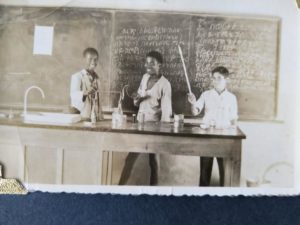In Debre Zeit as in other parts of Africa and round the world, in the 1950s and1960s learning materials and support were not readily available. The best and possibly the only option is to be either self-sufficient or seek out peer support wherever one can get it.
As often is the case, the ability and capacity of persons attending school varies vastly. Besides the persons innate gifts, this could be due to the socio-economic status of the family and availability of conducive learning environment to study such as electricity. Especially, persons attending school from the rural areas around Debre Zeit had a sever disadvantage to study as they do not have electricity at night when they have to do their homework and study.
To overcome the disadvantages and in the spirit of growing and achieving together, students started to tutor each other. Three things were put in place to facilitate the success of this arrangement. First an hour was added to the class hour known as study time/hour. After the last class, as the teacher leaves, students stay behind in class and the study period resumes.
Second, student tutors were selected based on the subject they are good at. Where there were students who are good in all subjects like Dr. Tebabu Tessema Wubetu, then they would tutor difficult subjects such as Math’s. The thinking behind the distribution of tutoring to different specialist students was mainly to increase participation, reduce burden of tutoring students and to get best results by involving those who are good in the subject.
Third and final arrangement was involving the class monitors to maintain discipline. Since there are no teachers who will oversee this period, it was essential to have an authority to oversee the tutoring is conducted in an orderly way. What is interesting was that the study period is the best run time of the day.
Another attention grabbing and productive aspect of the student led tutoring was the tutoring approach. The students who were assigned the different subjects were asked to prepare a question and answer to tutor. When they prepare the questions and answer the, it became evident that the tutors learn about the subject in depth and gained better insight.
The students who were tutored also learned better as they get answers to questions either they do not know how to ask or even if they know how to ask, were afraid to ask in class Infront of the teacher and class. The arrangement was mutually beneficial to both the tutor and those that are tutored. That is one unique benefit of this exercise.
While the study period tutoring is a formalized large-scale way of tutoring each other, there were other arrangement as well. For instance, there was friend to friend or small group tutoring arrangements. Friends or small group either go to school early before the start of class or stay behind after study hour and tutor each other using the same model or different approach.
Overall, this unique arrangement has helped a lot of students. these was the right solution for the situation at the time. Accordingly, some of the successes were visible in the number of students that have successfully completed high school and entered university. The success was not limited to university and there are indications it helped them beyond.
Table 2: Students in 1968 and 1969 who passed Ethiopian School Leaving Certificate Examination by province:
Provinces |
1968and 1969E.S.L.C.E Passes |
Rank order of passes |
ArussiBaleBegemeder & SemenEritreaGomu GofaGojjamHararheIllubaborKaffaShoaAddis AbebaSidamoTigreWellegaWollo |
7191182531–374431730718 |
813725114141219.559.56 |
